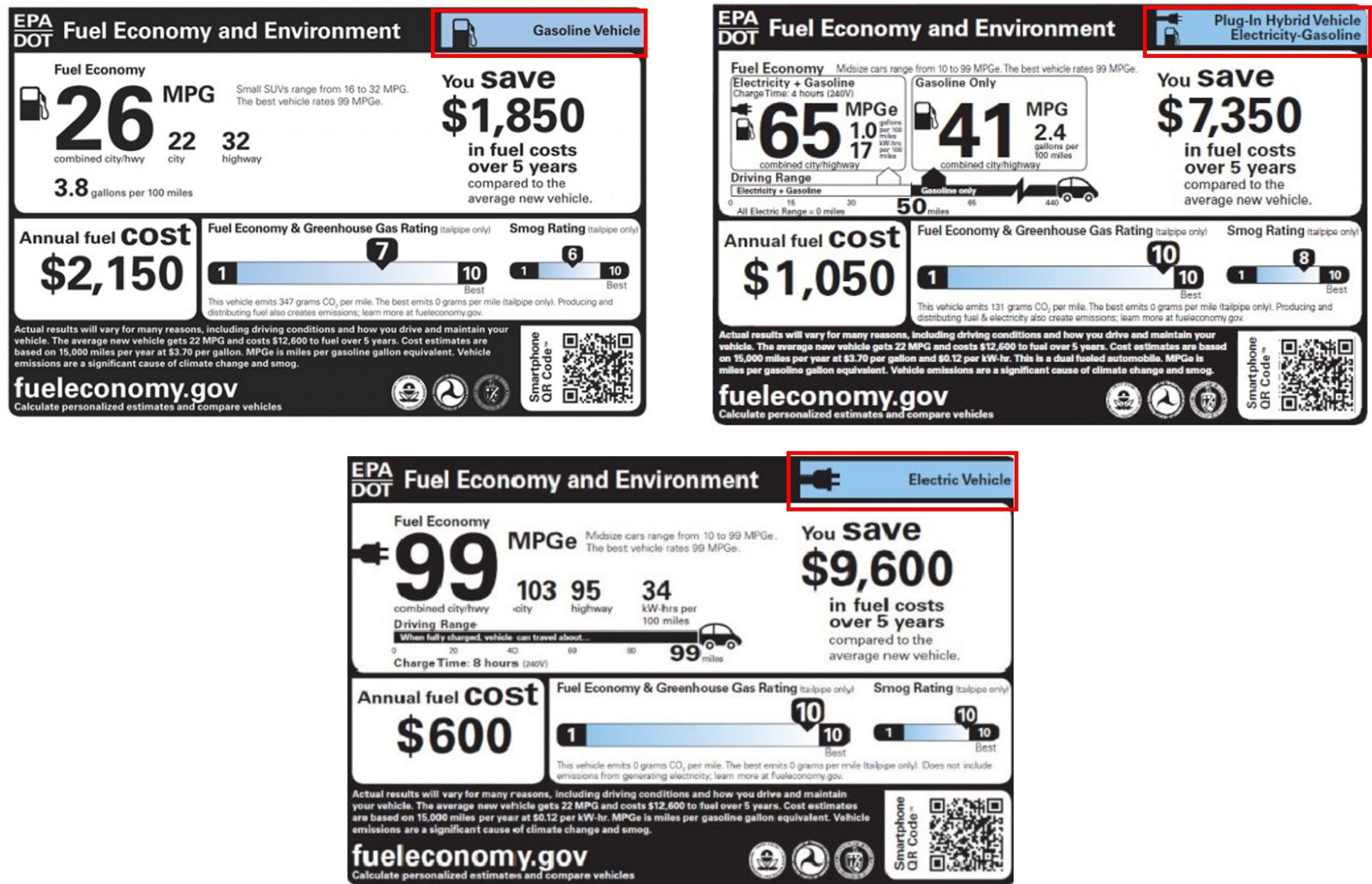
When shopping for any type of electric car, you’ll notice a slight change on the windshield label: A little “e” has found its way next to the age-old “MPG” fuel rating.
That’s because the Environmental Protection Agency (EPA) created a new fuel efficiency category for hybrid and fully electric cars in 2010. It stands for miles per gallon of gasoline equivalent, and car companies are federally mandated to display it.

EPA label examples showing MPG and MPGe for gasoline, hybrid, and fully electric vehicles. (Credit: EPA)
What Does MPGe Really Mean?
Like miles per gallon (MPG), the higher the MPGe the better. It estimates a car’s fuel efficiency, or how far it can go on a given quantity of fuel, whether the fuel is gasoline or electricity. This affects your driving experience in terms of how often you need to fuel up and how much you spend.
“Think of this as being similar to MPG, but instead of presenting miles per gallon of the vehicle’s fuel type, it represents the number of miles the vehicle can go using a quantity of fuel with the same energy content as a gallon of gasoline,” says the EPA website.
To calculate MPGe, the EPA figures one gallon of gasoline produces the same amount of energy as 33.7 kilowatt hours of electricity.
“MPG is also a measurement of efficiency, but it’s a lot easier for us to get our head around that, since ‘How far can I drive on a gallon of gas?’ is a straightforward concept,” says automotive journalist Tim Stevens. “For MPGe, the question is, ‘How far can my car drive on 33.7 kWh of electricity?’ That’s a lot harder to visualize. 33.7 kWh is considered to contain the equivalent energy as a gallon of gasoline, which is how we can convert between the two.”
MPGe for Hybrids vs. Plug-In Hybrids vs. EVs
MPGe only applies to plug-in hybrids and EVs. Regular hybrids still run primarily on gasoline with only a small electrical motor for peripheral functions like air conditioning. For example, let’s look at the Kia Niro, which comes in a hybrid, plug-in hybrid, and fully electric version.
-
The Niro hybrid has a 54MPG rating—Notice it doesn’t say MPGe. However, the presence of any electricity still increases the MPG compared with a fully gas-powered car.
-
The Niro plug-in hybrid has a 108MPGe combined rating—Plug-in hybrids, or PHEVs, run on electricity for a certain number of miles (33 on the Niro) before switching to gasoline. On a longer drive, after the electric capacity is depleted, the combined MPGe melds the fuel economy of the electric motor and the gas engine.
-
The Niro fully electric vehicle has a 113MPGe rating—Full EVs run exclusively on electricity with no backup gas engine, hence Kia dropped the “combined” from the plug-in hybrid and the EV simply says “MPGe.”
Does High MPGe Mean High Range?
A high MPGe on its own doesn’t necessarily mean a higher range. This can be counterintuitive since when we see a high MPG on a gasoline-powered car, we generally think it will require less frequent fill-ups (but the size of the tank also factors in, too).
“MPGe is a little tricky to think about because it’s a measurement of a car’s efficiency, not the distance it can travel,” says Stevens.
Recommended by Our Editors
For most EVs today, the battery (like the size of the gas tank) is much more of a limiting factor than energy efficiency. EV batteries are not yet as energy-dense as consumers would like, which means vehicles are stuck with lower ranges. So even if the vehicle is more efficient in using energy, it cannot necessarily hold as much energy at one time.
Using the Kia Niro example above, the EV has the highest MPGe but the lowest total range of the three.
-
Niro EV: 113MPGe, 253-mile range
-
Niro plug-in hybrid: 108MPGe, 510-mile total range
-
Niro hybrid: ~50MPG, range between 479-588 miles
Is It Better to Prioritize Range or MPGe?

Electric Volvo C40 Recharge (Credit: Emily Dreibelbis)
This depends on your driving habits. Most people do not need the 200-400 miles of range most EVs have on a daily basis. So, if saving money while driving around town is your biggest priority—perhaps you use a gas-powered or hybrid car for longer trips—go with the highest MPGe you can find. The EPA label includes estimated gas savings for each vehicle.
For longer trips, higher range is essential to reducing fueling stops along the way. A combination of the highest miles of range you can find, plus the highest MPGe, is the winner. It means the battery can hold more energy at one time, and it can go further with that power.
Like What You’re Reading?
Sign up for Tips & Tricks newsletter for expert advice to get the most out of your technology.
This newsletter may contain advertising, deals, or affiliate links. Subscribing to a newsletter indicates your consent to our Terms of Use and Privacy Policy. You may unsubscribe from the newsletters at any time.






